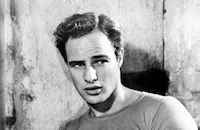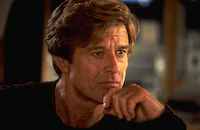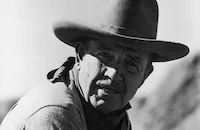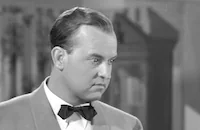The Chase

Brief Synopsis
Cast & Crew
Arthur Penn
Marlon Brando
Jane Fonda
Robert Redford
E. G. Marshall
Angie Dickinson
Film Details
Technical Specs

Synopsis
Tarl, a Texas town virtually owned by wealthy banker Val Rogers, is thrown into an uproar when it is learned that Bubber Reeves has escaped from the state penitentiary with another convict. The latter kills a motorist for his car and clothing and then leaves Bubber to shift for himself. Some of the Tarl residents believe Bubber guilty but others think him innocent. One of these is Sheriff Calder, who feels that Bubber will try to come home. The gossip, speculations, and predictions about Bubber's fate serve as the catalyst that alters the lives of some of the townspeople. There is his unfaithful wife, Anna, who has been having an affair with her husband's best friend, Jake, the only son of Rogers, who is himself unhappily married. Also affected are Calder's wife, Ruby, who devotedly tries to guide and protect her husband; Emily Stewart, the bored wife of the bank vice-president, who openly admits her sexual feelings for her husband's colleague Damon Fuller; and the latter's wife, Mary, driven to alcoholism by her loveless marriage. After a wild birthday party for Rogers, Sheriff Calder is mercilessly beaten by those opposing his strict maintenance of law and order. At the same time, Bubber arrives in town and seeks help from his wife and Jake Rogers. The news leaks out that he is hiding in an auto junkyard, and the whole town goes there to smoke him out. During the confusion, Jake is fatally injured by a gasoline explosion. Calder takes Bubber into custody and is leading him to jail when one of the town troublemakers, Archie, kills the young fugitive. Calder thrashes Archie, but Calder, aware that the situation is hopeless, leaves town with his wife to seek a better place to live.

Director

Arthur Penn
Cast

Marlon Brando

Jane Fonda

Robert Redford

E. G. Marshall

Angie Dickinson
Janice Rule

Miriam Hopkins

Martha Hyer
Richard Bradford

Robert Duvall
James Fox
Diana Hyland

Henry Hull

Jocelyn Brando
Katherine Walsh
Lori Martin
Marc Seaton
Paul H. Williams
Clifton James
Malcolm Atterbury
Nydia Westman

Joel Fluellen
Steve Ihnat
Maurice Manson

Bruce Cabot
Stephen Whittaker
Pamela Curran
Ken Renard

Eduardo Ciannelli
Richard Collier

Grady Sutton
Amy Fonda
Ralph Moody
George Winters
Howard Wright

Monte Hale
Mel Gallagher
Ray Galvin
Davis Roberts
Crew
Seth Banks
John Barry
Maurice Binder
John Cox
Richard Day
Don Feld
James Z. Flaster
C. M. Florance
Jim George
Doug Grant
James Havens
Lillian Hellman
Bob Hosler
Virginia Jones
Bill Kantor
David Koehler
Joseph La Shelle
Ben Lane
Harold Lee
Eugene Lenoir
Robert Luthardt
Harry Maret
Gene Milford
John Monte
William Lloyd Norton
Marie Osborne
Clarence Peet
Virginia Pherrin
Charles J. Rice
Russell Saunders
Marshall Schlom
Ed Shanley
Sam Spiegel
Robert Surtees
Bob Templeton
Eric Tomlinson
Frank [a.] Tuttle
Seldon White
Joe Wonder

Videos
Trailer
Promo
Film Details
Technical Specs

Articles
The Chase (1966)
The project was Spiegel's first film since his international success with Lawrence of Arabia, the Oscar®-winning Best Picture of 1962, and he wanted the celebrated playwright Lillian Hellman, whom he had always admired, to write the screenplay.
Foote's story was set in Texas and opens with a prisoner named Bubber Reeves escaping from jail with another inmate. During their getaway, they stop a car and the driver is killed by Reeves's companion who then abandons him there to take the blame. Instead he returns to his hometown to see his wife who is now involved in an affair with his best friend, Jake Rogers. The local populace, however, are outraged by Reeves's escape and purported crime and attempt to take the law into their own hands when the town sheriff, Calder, opposes their demands. He, of course, wants to see that Reeves is safely captured and receives a fair trial but Calder only endangers his own life with this stance.
From the beginning, Hellman agreed with Spiegel that The Chase "should concern itself with a society that is not too distant from frontier life." She stressed that "Such a society would carry with it violence, or the possibility of violence, because it must contain many displaced people who find that frontiers no longer exist." She also added that "Texas, unlike most of the South, is rich and powerful, and often shows a kind of anger that its convictions do not govern the rest of America...I would think that this is one of the reasons for the spitting at Adlai Stevenson and possibly one of the reasons of the handling - not the killing itself - of the Kennedy murder. It also accounts for Mr. Ruby." (from Sam Spiegel by Natasha Fraser-Cavassoni).
Marlon Brando had been linked to the film adaptation of The Chase from its earliest stage and was initially chosen by Spiegel for the role of Jake Rogers but after seven years had passed, he was considered too old for that role and cast instead as the town sheriff. It was never a movie he desperately wanted to do and after returning from witnessing a famine in Northeast India as part of a UNICEF tour, acting began to interest him less and less.
For the director, Spiegel had approached some of the biggest names in the film industry - David Lean, Elia Kazan, William Wyler, Fred Zinnemann, and Joseph L. Mankiewicz who felt the movie might be more powerful if the Reeves' character and his wife were African-Americans. All of them declined the offer. Arthur Penn, another contender to direct, wasn't interested at first until he heard Hellman had signed on as screenwriter. After that, he lobbied hard for the job and with Hellman in support of him was signed by Spiegel. At the time, Penn was still a rising talent in the industry but his Oscar® nomination for The Miracle Worker (1962) in 1963 added clout to his reputation and his previous film Mickey One (1965) showed he approached the medium as an art form and was open to experimentation and new movements such as the Nouvelle Vague which was sweeping Europe. This latter attribute, however, would cause some concern with the Columbia studio heads and later with Spiegel who operated like a Hollywood mogul from the studio system days.
The casting for The Chase was unconventional in that Spiegel actively pursued some actors for specific parts but let Penn pick many of the key roles. Spiegel was intent on Peter O'Toole playing Jason Rogers but when the actor absolutely refused, he awarded the role to James Fox. Spiegel also insisted on casting Jane Fonda and Robert Redford. Penn later admitted that he had never heard of Redford before The Chase but said "as far as casting, Sam was fantastic. He certainly had a clear view of what the film should be like. At first, he certainly delivered." It was also rumored that Spiegel used the "casting couch" technique to fill some of the smaller female roles in the film. Actress Pat Quinn (she later played the title character in Penn's Alice's Restaurant, [1969]) said, "On the set, it was thought that most of the women in the party scene had gone down on their knees for Sam...it was good old Hollywood."
Among the actors Penn brought on board for The Chase were Robert Duvall, who was still primarily a television actor except for his memorable appearance as Boo Radley in To Kill a Mockingbird [1962], E. G. Marshall, Janice Rule and Richard Bradford. The other high profile cast members included Angie Dickinson as the sheriff's wife, Ruby, Miriam Hopkins as Mrs. Reeves, Martha Hyer and Diana Hyland.
After Hellman delivered the screenplay, Spiegel still felt it needed work and brought in Ivan Moffat (Giant, 1956, Tender Is the Night, 1962) to rewrite it. "It was a bad version of High Noon [1952]," admitted Moffat whose own reworking of the script also included rewrites from Horton Foote as well. When Hellman read the new draft she was not pleased and stated "the bite and freshness and comment have been, in many places, lost altogether, and a rather well organized old fashioned quality has crept in."
The Chase was rapidly turning into a chore for Penn who was constantly subject to Spiegel's last minute changes or additions. For one thing, he couldn't hire his own cameraman. Instead Spiegel had given him Robert Surtees, a three-time Oscar®-winner who got sick on the job and had to be replaced. Without notifying Penn, Spiegel then hired Joseph LaShelle, another legendary cinematographer (The Apartment, 1960, Laura, 1944) who was a bad match for the younger director. "It should have been a close relationship," said Penn, "but I found him to be difficult and slow. For the night scenes, he would be lighting until midnight. And, in The Chase, we had a lot of night scenes." Penn also ran into other situations that taxed his patience. The film "required a certain amount of baby-sitting. Miriam Hopkins, who played Bubber's mother, she needed a great deal of care. Now, I have nothing but compassion for a former movie legend playing an old lady, but it takes up time."
If Penn had his production headaches, so did Spiegel who was constantly frustrated by Brando's behavior during the filming. Besides playing practical jokes on Spiegel, the actor refused to allow himself to be photographed for publicity purposes despite his contract which allowed him complete photo approval. He also created problems for the audio department because his line delivery was often too low and indecipherable. When he was asked to speak louder, he became obstinate, saying "I cannot sacrifice the mood of the scene for the sound track." But Brando would also offer valuable creative suggestions at times such as the staging of his vicious beating by angry townies. Penn recalled, "That was Marlon's idea. He said, "You know, I think the beating should be really savage." And I said, "Yeah, but how are you going to do it so savagely." So he showed me how to do it, which was to film it with slow motion acting and speeded-up camera. It doesn't show, it was just a few frames faster, but it was astonishing."
Jane Fonda, still trying to find herself as an actress, tried her best to make The Chase a success. After all, she had aggressively pursued the role after losing the part of Lara in Doctor Zhivago to Julie Christie. Despite the fact that Spiegel had launched a "nationwide search" for the role of Anna, she eventually convinced him she was perfect for the part and not some unknown. It also helped that she had an inside connection with Brando: her father Henry had studied acting with Brando's mother, a drama coach in Omaha. Once filming began, however, it was obvious that "Brando had lost interest in the film. Jane, Redford, and costar James Fox struggled to breathe life into the story, but the linchpin of the operation merely became more and more morose. To alleviate tension on the set, Jane took to imitating Brando's trademark acting style - the seemingly endless brooding silences, the perpetual scowl, and mumbled lines." (Citizen Jane: The Turbulent Life of Jane Fonda by Christopher Andersen).
As for Robert Redford, he spent most of his time being filmed by a second unit film crew as he ran through foliage and underbrush while off screen he occupied his time with fishing and hunting on location. When he was rehearsing his scenes with Brando, he learned they shared similar views on the plight of Native Americans. Redford also found a kindred spirit in Jane Fonda; they both shared similar political views and became friends, working together again as a screen team in the smash box office comedy Barefoot in the Park [1967] and The Electric Horseman [1979].
Once filming on The Chase was completed, the footage was shipped to London to be edited there but Penn first had a prior commitment to direct Wait Until Dark on Broadway. By the time he arrived in London, the director recalled (in an interview with Cineaste magazine), "they had already finished eight reels, scored and everything, and it was not a good cut. They left out some of the best material, including some of Brando's unique improvisations." Penn later stated, "I'm not saying the film would have been necessarily better if I had edited it, but I just knew the rhythm that was in my gut and it was not on that screen. The tempos were not right and I pride myself on the tempo and on the accumulating velocity that is part of the volume." Penn's unhappy experience on The Chase resulted in a promise to himself: "I won't touch anything I can't control to the end. And have fun with. Nothing's worth anything if you don't have fun." As if in retaliation for The Chase, Penn's next feature, Bonnie and Clyde (1967), was an international hit with both critics and audiences and is still considered a landmark American film and easily his greatest work.
Jane Fonda's own assessment of The Chase was more amusing: "It was a little like "Barbarella comes to small-town Texas." Maybe out of revenge for all those bad-hair years I'd endured, I was now playing second fiddle to a mane of hair that, as a friend recently said, should have had its own billing." Probably the most candid revelation of the movie's failure was the original screenwriter Lillian Hellman who said, "Decision by democratic majority vote is a fine form of government, but it's a stinking way to create. So two other writers were called in, and that made four with Mr. Spiegel and Mr. Penn, and what was intended as a modest picture about some aimless people on an aimless Saturday night got hot and large, and all the younger ladies in it have three breasts, and ---. Well, it is far more painful to have your work mauled about and slicked up than to see it go in a wastebasket."
As expected, most major film critics in the U.S. panned The Chase. The New Yorker proclaimed it "an opulent melodrama, overproduced by Sam Spiegel, overplotted to the point of incoherence...and overdirected." Bosley Crowther in The New York Times called it "a phony, tasteless movie...everything is intensely overheated." And Judith Crist in the New York Herald-Tribune wrote that it was "a mishmash of Peyton Place sociology, Western mythology, and Deep South psychology." She did, however, single out a few performances for praise: "Robert Redford is, at very least, the most nearly sympathetic character on hand as the bad boy; Robert Duvall is notable as the sexpot's weakling husband, a sneaky, cowardly kid who never grew up; and Richard Bradford is very good as the nastiest of the town's nasties."
European critics, however, praised The Chase seeing it as a telling indictment of violence in American society, particularly in France where it was released as La Poursuite Impitoyable. And since then, other defenders of the film have come forward such as critic Robin Wood who describes The Chase as "a seminal work" and Tom Milne of TimeOut Film Guide who wrote "it does manage to weave a credible pattern out of the tangled loyalties and enmities, which Penn's direction takes by the scruff and shakes into a firework display of controlled violence. Terrific performances too..." Clearly The Chase is overdue for a reevaluation.
Producer: Sam Spiegel
Director: Arthur Penn
Screenplay: Lillian Hellman, Horton Foote (play)
Cinematography: Joseph LaShelle, Robert Surtees
Film Editing: Gene Milford
Art Direction: Robert Luthardt
Music: John Barry
Cast: Marlon Brando (Sheriff Calder), Jane Fonda (Anna Reeves), Robert Redford (Charlie Reeves), E.G. Marshall (Val Rogers), Angie Dickinson (Ruby Calder), Janice Rule (Emily Stewart).
C-133m. Letterboxed.
by Jeff Stafford
SOURCES:
Sam Spiegel by Natasha Fraser-Cavassoni
Robert Redford by David Downing
My Life So Far by Jane Fonda Citizen Jane: The Turbulent Life of Jane Fonda by Christopher Andersen
Robert Duvall by Judith Slawson
"Cineaste, Spring 1993: An Interview with Arthur Penn" by Gary Crowdus & Richard Porton
"The New York Times: An Interview with Lillian Hellman" by Irving Drutman
www.afi.com
IMDB

The Chase (1966)
Quotes
Well now, Sheriff, it's nice to know that you're out here on patrol.- Damon
No, no, I'm not on patrol. Just lookin' for an ice cream cone, that's all.- Sheriff Calder
Trivia
The casting director rejected Faye Dunaway, telling her she wasn't pretty enough for movies and should stick to theater.
In the fight scene where Marlon Brado's character gets beaten up, for extra realism the director instructed the characters to punch Brando in extremely slow motion and actually connect with Brando's body. Due to the slow speed of the punches, Brando was not harmed at all. The scene was then processed at normal speed and the punches look as though they are causing serious damage to Brando.
Notes
Copyright length: 132 min.

Miscellaneous Notes
Released in United States February 17, 1966
Released in United States February 2007
Released in United States Winter February 1, 1966
Shown at Berlin International Film Festival (Homage) February 8-18, 2007.
Released in United States February 2007 (Shown at Berlin International Film Festival (Homage) February 8-18, 2007.)
Released in United States Winter February 1, 1966
Released in United States February 17, 1966















